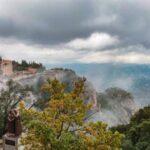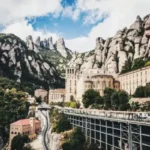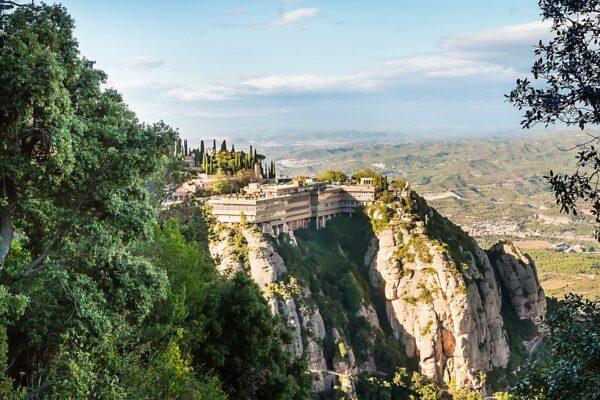
- Understanding the Spiritual Significance of Montserrat Monastery Traditions
- Cultural Etiquette: Dos and Don’ts at Montserrat Monastery
- The Role of Pilgrimage in Montserrat Monastery’s Spiritual Practices
- Exploring the Rich History Behind Montserrat Monastery's Rules
- How to Respect Local Customs while Visiting Montserrat Monastery
- The Impact of Color Symbolism in Montserrat Monastery's Spiritual Tradition
Montserrat Monastery, nestled in the breathtaking Catalan mountains, is a site steeped in rich spiritual heritage and cultural significance. The monastic community, along with the vibrant traditions surrounding this sacred place, attracts visitors seeking both enlightenment and a deeper understanding of its customs.
In this exploration, we delve into the essential customs and guidelines that govern life at Montserrat. **Unveiling the Rules of Montserrat Monastery: Exploring the Spiritual Traditions and Cultural Etiquette** reveals how these practices shape the experiences of pilgrims and tourists alike, fostering respect and reverence for this iconic spiritual sanctuary.
Understanding the Spiritual Significance of Montserrat Monastery Traditions
The spiritual significance of Montserrat Monastery traditions is deeply woven into the fabric of Catalan culture. Every aspect, from the rituals observed by the monks to the annual festivals, reflects a profound connection to the divine. Visitors to Montserrat often engage with these traditions, which include:
- The Feast of the Virgin of Montserrat: Celebrated with processions and prayers, it signifies the importance of the Virgin Mary in local spirituality.
- Daily Mass: This ritual serves as a cornerstone of monastic life, inviting both monks and pilgrims to participate in communal worship.
- Spiritual Retreats: Offering a chance for deep reflection, retreats at Montserrat encourage visitors to explore their own spirituality.
Understanding these traditions is essential for grasping the essence of Montserrat as a spiritual retreat. The monastery not only serves as a place of worship but also as a cultural hub where various practices intersect. The blend of religious devotion and Catalan cultural identity creates a unique atmosphere that resonates with both the heart and spirit of those who visit.
Furthermore, the rich history of Montserrat has shaped its spiritual practices, particularly through the stories of miraculous sightings and divine interventions attributed to the Virgin of Montserrat. These narratives add layers of meaning to the rituals performed, making each visit an opportunity to witness the interplay of faith and tradition. Key elements of this historical context include:
- Legends of Miracles: Tales of healing and divine assistance that enhance the spiritual aura of the site.
- Artistic Expressions: The monastery houses numerous artistic treasures that tell the story of faith through sculpture, painting, and music.
In essence, the traditions of Montserrat Monastery offer not only a glimpse into its spiritual significance but also a pathway for personal transformation. Engaging in these customs allows visitors to cultivate a deeper understanding of their own beliefs while participating in a time-honored legacy that continues to inspire countless souls.
Cultural Etiquette: Dos and Don’ts at Montserrat Monastery
When visiting Montserrat Monastery, it is essential to observe certain cultural etiquette to honor the spiritual atmosphere of the site. Dos and Don’ts can help ensure that your visit is respectful and enriching, allowing you to connect with the traditions of this sacred place.
Dos:
- Dress modestly: It is recommended to wear clothing that covers the shoulders and knees, as a sign of respect in this religious environment.
- Speak softly: Maintain a calm demeanor and keep your voice low, as this is a place for contemplation and prayer.
- Participate in rituals: Engage respectfully in the daily Mass or other ceremonies, as it enhances your understanding of the monastic life.
Don’ts:
- Do not take photos during services: Photography can be disruptive during worship, so it's best to wait until after services to capture the beauty of the monastery.
- Avoid loud conversations: Being mindful of your surroundings helps maintain the serene atmosphere of Montserrat.
- Do not touch sacred objects: Respect the sanctity of altars and religious artifacts by refraining from touching them without permission.
Adhering to these cultural etiquette guidelines at Montserrat Monastery allows you to fully appreciate its spiritual traditions. By being considerate of the monastic community and the other visitors, you contribute to a peaceful and meaningful experience for everyone present.
The Role of Pilgrimage in Montserrat Monastery’s Spiritual Practices
Pilgrimage to Montserrat Monastery plays a crucial role in its spiritual practices, serving as a profound journey for self-reflection and connection with the divine. Many visitors embark on this pilgrimage to seek spiritual guidance, healing, and a deeper understanding of their faith. The experience of physically traveling to such a sacred site enhances the spiritual significance of the visit, often leaving a lasting impact on the pilgrims' lives.
During their pilgrimage, visitors engage in various spiritual rituals that foster a sense of community and devotion. Common practices include:
- Praying at the Black Madonna: The veneration of the revered statue encourages personal prayer and reflection.
- Walking the Trails: Scenic paths lead pilgrims through nature, providing opportunities for contemplation and connection with the surrounding beauty.
- Participating in Group Services: Shared worship experiences strengthen bonds among pilgrims and the monastic community.
The journey to Montserrat not only serves as a physical endeavor but also as a metaphorical ascent toward enlightenment. As pilgrims navigate the challenging terrain, they often find parallels with their spiritual struggles, leading to a transformative experience. Many leave the monastery feeling rejuvenated, with renewed faith and clarity on their spiritual path.
This pilgrimage tradition is deeply embedded in the cultural fabric of the region, reflecting the perseverance and devotion of those who seek solace in Montserrat. The intertwining of personal faith with communal traditions creates a unique environment where pilgrims can explore their spirituality while immersed in the rich historical context of the monastery.
Exploring the Rich History Behind Montserrat Monastery's Rules
The history of Montserrat Monastery is rich and multifaceted, reflecting its significance as a spiritual and cultural landmark. Founded in the 10th century, it has evolved through the centuries, shaped by various historical events, including the Spanish Civil War and the rise of Catalan nationalism. These factors influenced the establishment of rules and traditions that guide the monastery’s daily life, ensuring its survival and relevance in modern times.
Central to Montserrat's identity is the preservation of monastic life, which emphasizes prayer, community, and service. The rules governing the monks' way of living are rooted in the teachings of St. Benedict, known for his balance of work and prayer. This framework not only supports the spiritual growth of the monks but also invites visitors to engage with a tradition that has been upheld for centuries. Key historical influences include:
- The Benedictine Rule: Establishes the guidelines for monastic living, focusing on hospitality, humility, and devotion.
- Historical Pilgrimages: The influx of pilgrims throughout the ages has shaped the monastery’s practices and hospitality.
Moreover, Montserrat's infamous legends, such as those surrounding the Black Madonna, add a layer of depth to its rules. These stories are more than mere folklore; they embody the spiritual essence that draws countless visitors every year. The intertwining of legend and ritual creates a unique atmosphere where sacred traditions are actively lived and experienced, reinforcing the monastery's role as a center of spirituality and cultural heritage.
Overall, the rules of Montserrat Monastery are not merely regulations; they represent a living tradition that bridges the past and present. By understanding the history behind these rules, visitors can better appreciate the profound spiritual journey that Montserrat offers, making each visit a significant encounter with both faith and history.
How to Respect Local Customs while Visiting Montserrat Monastery
When visiting Montserrat Monastery, it is crucial to respect local customs to ensure a harmonious experience. First and foremost, visitors should be aware of the spiritual significance of the site. Engaging mindfully with the traditions, such as participating in the daily Mass, not only honors the monastic community but also enhances your understanding of their way of life. This shared spiritual experience fosters a deeper connection with both the monastery and fellow visitors.
Another important aspect of respecting local customs is adhering to dress codes. It is recommended to wear modest clothing, covering shoulders and knees, as a sign of respect in this sacred space. This practice is a common courtesy in many religious sites, reflecting your acknowledgment of the monastery's spiritual and cultural values. Additionally, dressing appropriately helps maintain the serene atmosphere that the community cherishes.
Visitors should also be mindful of their behavior while at Montserrat. Maintaining a quiet demeanor and avoiding loud conversations allows everyone to engage in personal reflection and prayer. Remember, this is a place of contemplation, and your respectful conduct contributes to the peaceful environment that many seek. Observing these simple guidelines can significantly enhance the overall experience for both you and fellow pilgrims.
Lastly, being aware of specific customs, such as refraining from photographing during services, is essential. While capturing memories is important, allowing the ritual to unfold without distractions honors the sanctity of the moment. Respecting these local customs not only enriches your visit but also helps preserve the cultural integrity of Montserrat Monastery, making it a welcoming space for future generations of visitors.
The Impact of Color Symbolism in Montserrat Monastery's Spiritual Tradition
The use of color symbolism in Montserrat Monastery plays a significant role in its spiritual tradition, enriching the experience of both monks and visitors alike. Each color found within the monastery's architecture, vestments, and sacred art carries profound meanings that resonate with the spiritual narratives of the site. For instance, the predominant use of gold represents divine glory and the presence of the divine, while blue symbolizes serenity and the grace of the Virgin Mary, central to Montserrat's spirituality.
Moreover, the vibrant hues found in various liturgical settings serve to heighten the emotional connection to rituals and ceremonies. Colors are intentionally selected to align with specific liturgical seasons and celebrations, creating a visual language that enhances spiritual engagement. Key color meanings include:
- Red: Signifying sacrifice and love, often used during important feasts.
- White: Representing purity and resurrection, frequently seen during celebrations of the Virgin Mary.
- Purple: Associated with penance and reflection, dominant during the Lenten season.
The impact of these colors extends beyond mere aesthetics; they invoke a deeper connection to the rich spiritual narratives that define Montserrat Monastery. Visitors often find that understanding the symbolism behind colors enhances their appreciation of the sacred space, allowing for a more immersive experience. By engaging with these colors, one can better grasp the intertwining of artistic expression and spiritual devotion that characterizes this beloved sanctuary.
In essence, color symbolism at Montserrat Monastery serves as a bridge between the material and the spiritual. It invites pilgrims and visitors to reflect on their personal journeys while encouraging a shared understanding of the cultural and religious significance embedded in this beautiful landscape. Through this lens of color, Montserrat continues to inspire devotion and reverence, embodying the very essence of its spiritual heritage.
 Exploring the Majestic Montserrat Monastery: A Spiritual Oasis in Spain
Exploring the Majestic Montserrat Monastery: A Spiritual Oasis in Spain Exploring Montserrat Monastery: Weather and Temperature Guide
Exploring Montserrat Monastery: Weather and Temperature Guide From Montserrat Monastery to Barcelona: Exploring Catalonia's Spiritual and Cultural Wonders
From Montserrat Monastery to Barcelona: Exploring Catalonia's Spiritual and Cultural Wonders Why is Montserrat Monastery Important: Unveiling the Spiritual and Cultural Significance
Why is Montserrat Monastery Important: Unveiling the Spiritual and Cultural SignificanceIf you want to know other articles similar to Unveiling the Rules of Montserrat Monastery: Exploring the Spiritual Traditions and Cultural Etiquette you can visit the category WHERE YOU CAN GO.
Deja una respuesta










Read more!